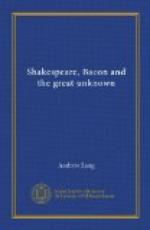“But, at any rate, we have the Stratford monument,” says Mr. Greenwood, and delves into this problem. Even the Stratford monument of Shakespeare in the parish church is haunted by Baconian mysteries. If the gentle reader will throw his eye over the photograph {177a} of the monument as it now exists, he may not be able to say to the face of the poet —
“Thou wast that all to me, Will,
For which my soul did pine.”
But if he has any knowledge of Jacobean busts on monuments, he will probably agree with me in saying, “This effigy, though executed by somebody who was not a Pheidias, and who perhaps worked merely from descriptions, is, at all events, Jacobean.” The same may assuredly be said of the monument; it is in good Jacobean style: the pillars with their capitals are graceful: all the rest is in keeping; and the two inscriptions are in the square capital letters of inscriptions of the period; not in italic characters. Distrusting my own expertise, I have consulted Sir Sidney Colvin, and Mr. Holmes of the National Portrait Gallery. They, with Mr. Spielmann, think the work to be of the early seventeenth century.
Next, glance at the figure opposite. This is a reproduction of “the earliest representation of the Bust” (and monument) in Dugdale’s Antiquities of Warwickshire (1656). Compare the two objects, point by point, from the potato on top with holes in it, of Dugdale, which is meant for a skull, through all the details,—bust and all. Does Dugdale’s print, whether engraved by Hollar or not, represent a Jacobean work? Look at the two ludicrous children, their legs dangling in air; at the lions’ heads above the capitals of the pillars; at the lettering of the two visible words of the inscription, and at the gloomy hypochondriac or lunatic, clasping a cushion to his abdomen. That hideous design was not executed by an artist who “had his eye on the object,” if the object were a Jacobean monument: while the actual monument was fashioned in no period of art but the Jacobean. From Digges’ rhymes in the Folio of 1623, we know that Shakespeare already had his “Stratford monument.” The existing object is what he had; the monument in Dugdale is what, I hope, no architect of 1616-23 could have imagined or designed.
Dugdale’s engraving is not a correct copy of any genuine Jacobean work of art. Is Dugdale accurate in his reproductions of other monuments in Stratford Church? To satisfy himself on this point, Sir George Trevelyan, as he wrote to me (June 13, 1912), “made a sketch of the Carew Renaissance monument in Stratford Church, and found that the discrepancies between the original tomb and the representation in Dugdale’s Warwickshire are far and away greater than in the monument to William Shakespeare.”
Mr. Greenwood, {179a} while justly observing that “the little sitting figures . . . are placed as no monumental sculptor would place them,” “on the whole sees no reason at all why we should doubt the substantial accuracy of Dugdale’s figure . . . It is impossible to suppose that Hollar would have drawn and that Dugdale would have published a mere travesty of the Stratford Monument.”




